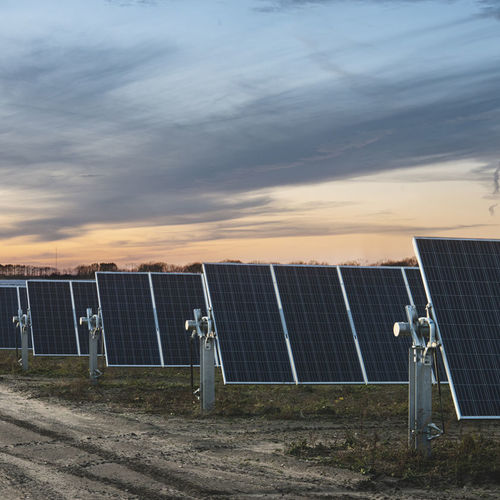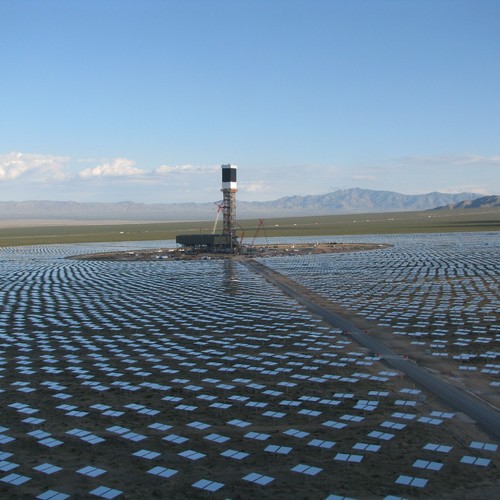
Image Credit: U.S. Army
Fort Bliss – whose 1.2 million acres stretch from West Texas, near El Paso, into New Mexico – is the U.S. Army’s largest post by land area, and it faces a commensurately large conservation challenge: severe reductions in the base’s energy and water use, and a 90% reduction in trash headed for landfill.
As a recent Texas Tribune story points out, Bliss and Fort Carson in Colorado were both selected by the Army to achieve what the service describes as “net zero” performance in all three areas by 2018. With the base’s population to soon reach 30,000, that is going to be a monumental task, and we’ll make no predictions about its chances for success.
One thing is clear, though: Fort Bliss, whose grid power already is supported by a newly installed, $1 million photovoltaic system, will soon be home to substantially more PV panels. Earlier this year, the Army awarded a $16 million federal contract to energy services provider Johnson Controls, which will install and maintain 5,500 PV panels. That’s enough to double the base’s solar capacity, although once the installation is in place, by the end of the year, PV would still cover only about 1% of Fort Bliss’s electricity usage, the Tribune noted.
Fort Bliss also expects construction will commence on another, 20-megawatt PV project next year.
Plenty of room
There is plenty of room at Fort Bliss to expand PV coverage – the base is slightly bigger than Rhode Island – but getting its facilities’ energy usage significantly closer to zero will obviously require its renewable-energy and sustainable engineering program leaders to pursue other measures, including construction and materials strategies that best offset the extremes of the arid Southwestern climate.
Too, Fort Bliss is only one example of the Army’s push toward energy and resource conservation: several, similar initiatives are underway, including the one at the U.S. Military Academy at West Point, where facilities upgrades will include construction of new, energy efficient barracks in addition to installations of renewable-energy and power-monitoring systems.
Beyond PV
While PV installations may offer visible evidence that the Army is attempting to move away from reliance on the grid, it will be interesting to see how, and on what scale, it achieves energy savings through other means, including new-construction and retrofit standards that focus on insulation and airtightness. In many ways, these military initiatives might end up tracking trends already underway in Europe, where subsidies for solar power, usually in the form of feed-in tariffs, are being cut because they tend to overemphasize deployment of PV and underemphasize innovation research in PV and other renewable-energy and energy-saving technologies.
As GreenBiz.com writer Marc Gunther explained in a blog post last month, “Perhaps the most obvious takeaway is that we should not place expensive bets on any one solution. That’s what the Germans did, with generous subsidies in the form of a feed-in tariff for solar. Even though the costs of solar have dropped dramatically, the subsidies were not sustainable. Remember when people said nuclear was too cheap to meter? Solar PV is too costly to subsidize on a scale that matters.”
Competing with natural gas
Last month, think tank Breakthrough Institute released an analysis of the challenges that falling natural gas prices and the scheduled decline in federal funding for clean-energy technologies likely will have on the wind, solar, and nuclear energy markets.
Titled “Gas Boom Poses Challenges for Renewables and Nuclear,” the report points out that, with a 60% decline in PV module prices in 2011, the cost of electricity from unsubsidized rooftop solar (on both residential and commercial buildings) is close to retail electricity rates in markets where solar irradiance is relatively high (California, Florida, Nevada, Texas) and but also in parts of the Northeast, where the retail cost of electricity tops $160 per MWh.
The problem is that utility-scale PV plants in all but the sunniest markets still can’t compete with rates charged by gas-fired plants, and with federal subsidies for solar timing out, the prospects are dimming for both expanded investment in PV innovation and deployment.
“In order to counteract the daunting obstacles facing clean energy today, the United States must create policies that simultaneously drive market growth and continual technological improvement,” the Breakthrough analysis concludes. “Signiï¬cant progress has already been made. But considering the competition of newly cheap and abundant natural gas and the technical and infrastructural challenges facing clean energy today, more innovation is needed to secure a zero-carbon energy future.”
Weekly Newsletter
Get building science and energy efficiency advice, plus special offers, in your inbox.













One Comment
Richard, Feed-in-tariffs are not really subsidies.
In my book, a subsidy involves a direct payment from the government to an organization or class of individuals. In contrast, tariffs are above market payments from utilities to providers of renewable energy that sell to the utility. In turn the utility increases the per kilowatt charge to all of its customers, which has added about 1 cent per kWh to customer's bills. Feed-in-tariffs are both self-financing and popular in Germany. They also apply to wind, biogas, hydro, and geothermal.
One major reason feed-in-tariffs are being reduced is because of the very significant reductions in the cost of PV systems. While the year-one feed-in-tariff for solar has dropped from .58 cents Euro per kWh to .18 cents Euro today, the payback for a cash on the barrel PV system has remained 6 to 7 years, and 10 to 12 years with a bank loan.
Unlike our helter skelter approach (30% rebate on investment), feed-in-tariffs require actual energy production and reward efficient systems. It might be fair to say that we had bankers devising our half-baked approach whereas engineers, systems planners, and visionaries designed the German system.
There is another benefit to this approach. About half of the PV systems and wind turbines in Germany are owned by private citizens. See: http://www.treehugger.com/renewable-energy/over-half-germany-renewable-energy-owned-citizens-not-utility-companies.html
The feed-in-tariff law has created one of the most successful public-private partnerships ever conceived. We would do well to opt for this approach.
Log in or create an account to post a comment.
Sign up Log in